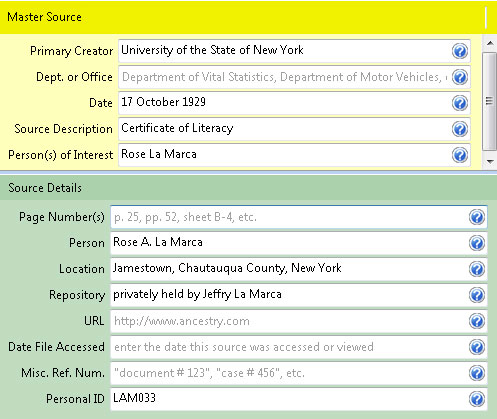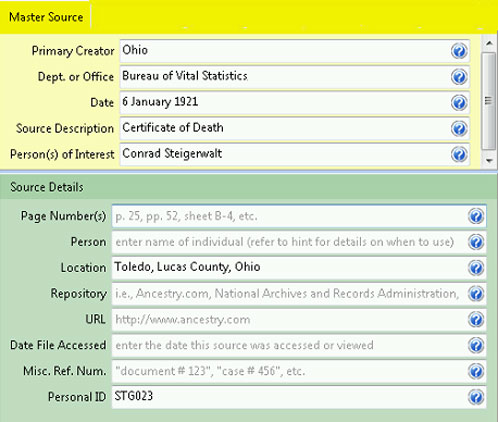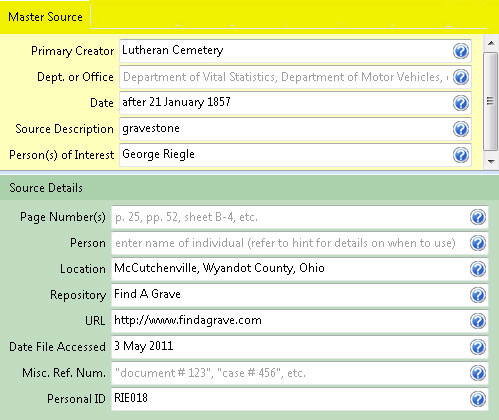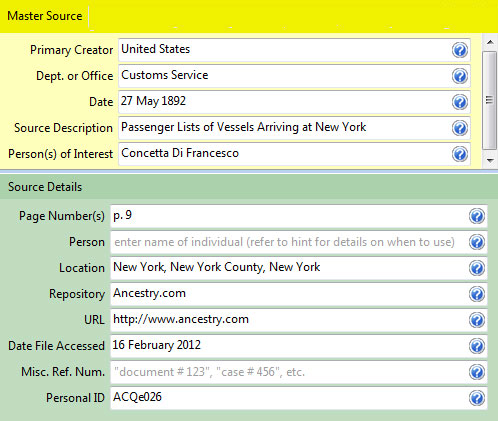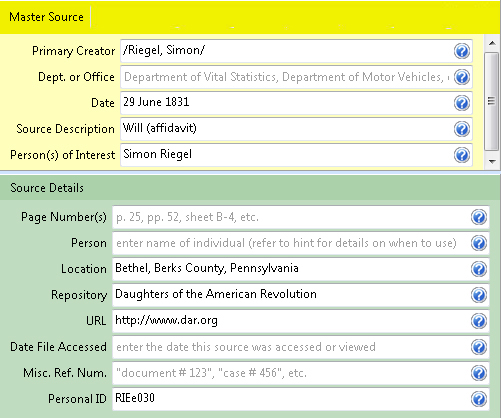Template Examples: Non-traditional
Most family historians will spend a considerable about of time dealing with non-traditional records. This template contains a total of 13 elements, three of which are REQUIRED (these are highlighted in red). The following describes each field and examples of census record entries are provided.
Master Source
- Primary Creator: Provide the name of the individual(s) who created the source (in many cases, the name of an agency or other entity will be used). In instances where a specific person or agency can't be identified, the name of the entity where to source is located can be used. A prime example is in the case of citing a headstone; the name of the person or company that created it are nearly never know; in such case, it is appropriate to list the name of the cemetery where the headstone is located. This field is REQUIRED.
- Dept. or Office: Input the department, office, government agency, or other entity that is responsible for creating this source.
- Date: Enter the exact date (if known) that this source was created, indexed, or first came into being. As this is a REQUIRED field, if you don't know the exact date, then provide an estimate with a qualifier (e.g., about, between, circa).
- Source Description: Used for documents and sources where a person or persons name are the main topic.
Examples:
- Birth Certificate
- Diploma
- Golf Club Membership Card
- Headstone
- Letter (or Personal Correspondence)
- Marriage Certificate
- Passenger Ship List, S.S. Trojan Prince
- Photograph
- 1880 U.S. Census
Use "title casing" for capitalization. The field should be kept as generic as possible. A few sources may require clarification. For example, passenger ship records should list the name of the ship. Date or other very specific information should not be included except for census records (the year distinguishes one census from another).
- Person(s) of Interest: If this source refers to a specific individual, list his or her name. If two individuals are listed and are of equal primary importance to the source (e.g., a wedding couple), list as: Ralph Brown and Jane Doe If this source refers to a group of individuals of primary interest, list by family names (e.g. Brown Family, Smith Family, Brown and Smith Families), or by group (e.g., Doe cousins, Smalltown Bowling Club, Boy Scouts from Troop XYZ, etc.).
Source Details
- Page Number(s): The only information that should be listed here is the page number. This field is almost never used with this template.
- Person: This is an optional element and should only be used if more than one person's name (or that of a group) is listed on the master source. This element is also used to recognize the person's inclusion in a book or periodical..
- Location: Provide location where the source was created (if not mentioned above), it's physical location (e.g., grave site), or where the event occurred (location of baptism, place of census, marriage location, etc.)
- Repository: This is an optional field that I only use if this source was obtained over the Internet of if it's a one-of-a-kind document that is held in a private collection. If this document was obtained from a library, DO NOT list the repository.
- URL: Although the full URL may be appropriate, listing only the home page of sites where a document is located (e.g., http://www.ancestry.com) is sufficient as many of these, particularly those from commercial sites that require subscriptions; listing the full URL from commercial sites will not be useful to those who don't subscribe. There is also a fairly new standard that genealogists haven't yet adapted - that is the use of a "Digital Object Identifier" - this is a number that is now attached to many electronic sources available on the Internet. In the unlikely event that a DOI is available, use that instead of the URL. Information on DOIs can be found here.
- Date File Accessed: This is another optional field that I only use to cite sources that were obtained on the Internet. In all other cases, it should be left blank.
- Misc. Ref. Num.: I have now used Simple Citations for more than ten years and have used this field on only a few occasions. Use this field sparingly.
- Personal ID: The information placed in this field refers to the personal numbering system you use to organize your family history. This information should never be printed on reports or in your citations. It is only used to help you keep track of your documentation.
Examples
- Certificates
- Certificate of Literacy
- Death Certificate
- Marriage Certificate
- Diplomas
- Gravestones
- Passenger Lists
- Personal Correspondence
- Wills

